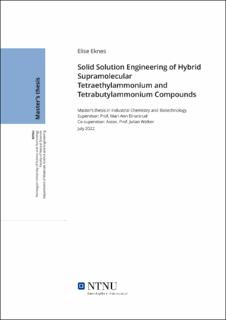| dc.description.abstract | Plastiske krystaller er supramolekylære materialer som gjennomgår en fasetransformasjon til en mesofase ved forhøyede temperaturer. I mesofasen har molekylene eller ionene rotasjonell frihet samtidig som de er begrenset til krystallgitteret. Denne fasetransformasjonen er som regel fulgt av en stor entalpi- og entropiendring, som betyr at mange plastiske krystaller har potensialet til å lagre store mengder termisk energi i systemer for termisk energilagring. Slike systemer kan forhindre tap av varme til omgivelsene og dermed øke energieffektiviteten til husholdninger og fornybare energiteknologier betraktelig. Tetraetylammonium og tetrabutylammonium bromotrikloroferrat(III) er hybride plastiske krystaller som går gjennom en fasetransformasjon til denne mesofasen. De består av ulike kationer, men samme anion. Ved å lage en fast løsning mellom disse to plastiske krystallene vil kationet endres, noe som kan føre til endringer i de termiske egenskapene. Dermed kan for eksempel fasetransformasjonstemperaturen og entropien endres for å skape termisk energilagringsystemer for mange ulike anvendelser. I denne studien ble tetraetylammonium og tetrabutylammonium bromotrikloroferrat(III) syntetisert med en vann-basert syntesemetode. Videre ble det forsøkt å lage en fast løsning mellom disse to forbindelsene for å syntetisere materialer av TEAxTBA1-xFeBrCl3. Røntgendiffraksjon og differensiell skanningskalorimetri ble deretter benyttet for å analysere hvordan krystallstrukturen, fasetransformasjonstemperaturen, entalpien og entropien endres som en funksjon av komposisjon. Tetraetylammonium og tetrabutylammonium bromotrikloroferrat(III) ble syntetisert med et utbytte på henholdsvis 96.4% og 87.6%. Materialer av TEAxTBA1-xFeBrCl3, med x = 0.05, 0.1, 0.15, 0.25, 0.50 og 0.75, ble syntetisert ved å varmebehandle støkiometriske blandinger av pulvere på 240 °C. Resultatene fra røntgendiffraksjonen viste at både P63mc- og Pnna-fasen er tilstede i alle materialene, og man kan konkludere med at det ikke dannes noen fast løsning mellom tetraetylammonium og tetrabutylammonium bromotrikloroferrat(III) ved romtemperatur. Et tilnærmet fasediagram for systemet ble konstruert med resultater fra differensiell skanningskalorimetri. Dette fasediagrammet viser at det derimot finnes en fast løsning i mesofasen ved forhøyede temperaturer for materialer som inneholder 5-15 mol% tetraetylammonium bromotrikloroferrat(III). For materialer som inneholder mer enn 25 mol% tetraetylammonium bromotrikloroferrat(III), smelter en av fasene rundt 105 °C. Dette fører til en faseseparasjon mellom den dannede væskefasen og den faste fasen. | |
| dc.description.abstract | Plastic crystals are supramolecular materials that undergo a phase transition to a mesophase with increasing temperatures, where the molecules or ions have short-range orientational disorder and long-range positional order. This transition is often accompanied by a large change in the enthalpy and entropy, meaning most plastic crystals have a large potential to store thermal energy in thermal energy storage systems. Such systems show great promise in preventing loss of excess heat to the environment, thereby increasing the energy efficiency of households and renewable technologies significantly. Tetraethylammonium and tetrabutylammonium bromotrichloroferrate(III) are both hybrid plastic crystals, that are comprised of different cations and the same anion, and go through this high entropy mesophase transition. By creating a solid solution between these two plastic crystals, the thermal properties can be adjusted by changing the cation. As a result, properties such as the phase transition temperature and enthalpy can be tuned to create thermal energy storage systems specified for a wide variety of applications. In this study, tetraethylammonium and tetrabutylammonium bromotrichloroferrate(III) were synthesised using a water-based evaporation crystallisation. Further, solid solution engineering between the two end member materials was utilized to create TEAxTBA1-xFeBrCl3 materials. X-ray diffraction and differential scanning calorimetry were used to analyse how the crystal structure, phase transition temperature, enthalpy, and entropy change as a function of composition. Tetraethylammonium and tetrabutylammonium bromotrichloroferrate were synthesised with a yield of 96.4% and 87.6%, respectively. Materials of TEAxTBA1-xFeBrCl3 with x = 0.05, 0.1, 0.15, 0.25, 0.50, and 0.75, were synthesised through an annealing process where stoichiometric mixtures of powders were heated to 240 °C. From X-ray diffraction measurements and Rietveld refinement, it was found that no clear solid solution formation occurs between the two end member materials at room temperature, as the presence of both P63mc and Pnna phases are observed in all compounds. However, the construction of an approximate phase diagram for the system using differential scanning calorimetry, show a miscible mesophase region at elevated temperatures for samples containing 5-15 mol% tetraethylammonium bromotrichloroferrate(III).
For samples containing more than 25 mol% tetraethylammonium bromotrichloroferrate(III), on the other hand, one of the phases melts around 105 °C, creating a phase separation between the liquid and solid phase. | |
